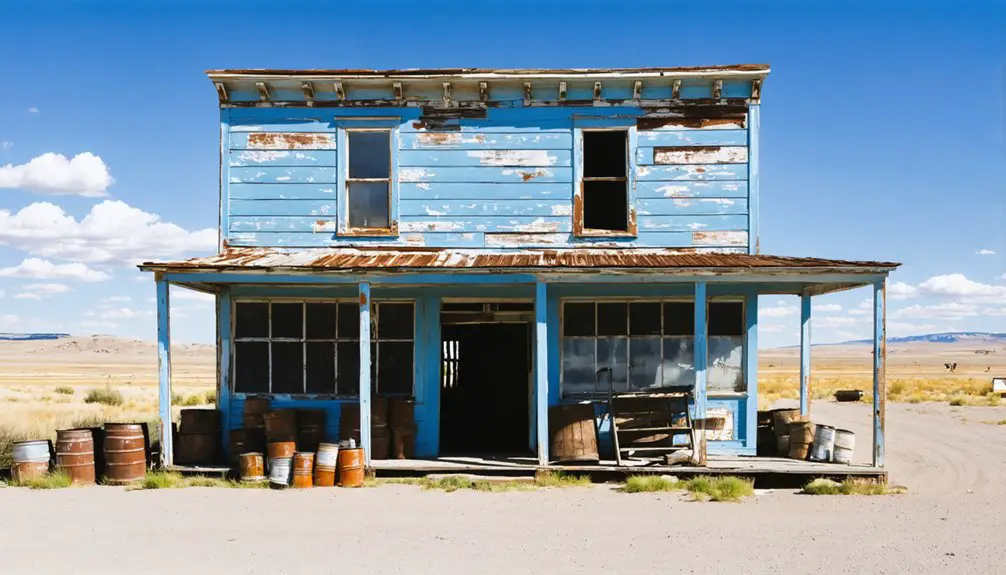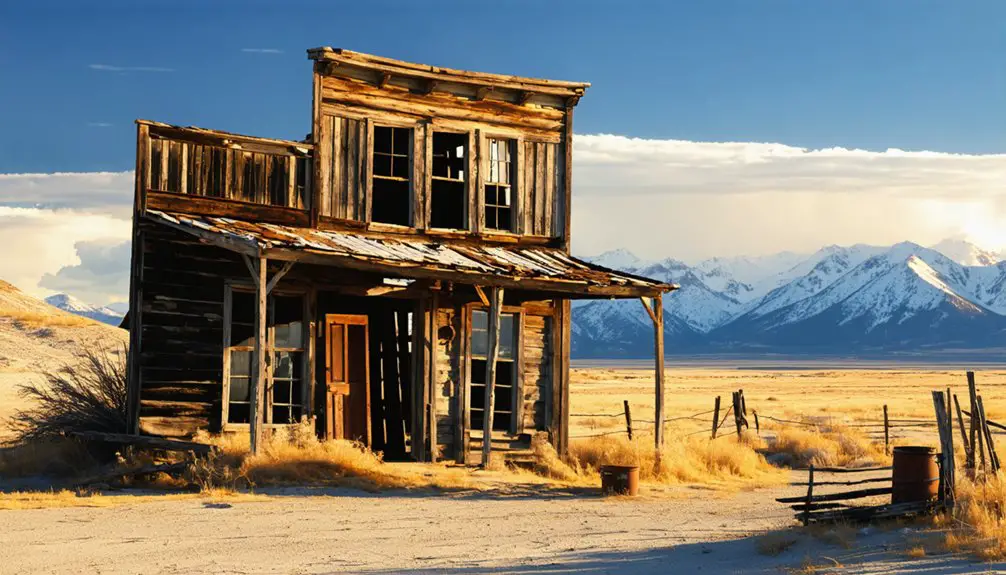You’ll find Canyon Springs located 35 miles south of Deadwood, where it emerged as a strategic gold mining settlement during the 1874 Black Hills rush. The town thrived as a stagecoach station, handling gold shipments worth up to $300,000, while supporting a diverse community of 15,000 miners from 56 nations. After battling harsh winters and economic struggles, Canyon Springs declined by 1928, leaving behind fascinating ruins and a historic cemetery that tell stories of frontier determination.
Key Takeaways
- Canyon Springs was a Black Hills mining town 35 miles south of Deadwood that served as a strategic stagecoach station transporting gold shipments.
- The town experienced rapid decline between 1882-1907 due to severe blizzards that paralyzed mining operations, forcing residents to abandon it.
- Today’s ghost town remnants include foundations, charred wooden planks from an 1890 fire, and a historic cemetery.
- Access requires four-wheel-drive vehicles or hiking through Horse Thief Canyon, with visitors needing appropriate gear and supplies.
- The site preserves evidence of both gold rush and coal mining eras, with production growing from 12,007 tons in 1906 to 891,000 tons by 1916.
The Gold Rush Origins of Canyon Springs
When gold was discovered in the Black Hills during Custer’s 1874 expedition, it sparked a rush that would shape the destiny of Canyon Springs.
Located 35 miles south of Deadwood, this strategic location became an essential hub as prospectors flooded the region in search of fortune.
Deep in the Black Hills, Canyon Springs emerged as a vital crossroads where fortune seekers converged in their quest for gold.
You’ll find that Canyon Springs’ story began with placer gold, those loose particles that had eroded from nearby rock deposits. The discovery brought an estimated 15,000 miners into the Black Hills territory. The region’s deposits were primarily free milling gold, making early extraction methods relatively straightforward.
While the Homestake Mine near Deadwood dominated with its successful lode mining operations, Canyon Springs emerged as a key stagecoach station, facilitating the transport of massive gold shipments worth up to $300,000.
However, this prosperity came at a cost – the mining activities violated the Treaty of Fort Laramie, creating tensions with the Sioux who considered these lands sacred.
Life in a Bustling Mining Community
Within Canyon Springs’ bustling mining community, you’d find a diverse tapestry of immigrant families and laborers who shaped the town’s vibrant social fabric.
Community cohesion emerged naturally as miners relied on each other for safety during their demanding shifts underground. The town welcomed workers from 56 different nations, creating an incredibly multicultural atmosphere. You’d witness families living in tents and company housing, sharing daily struggles while earning up to $90 in today’s money during prosperous times.
Your life would revolve around the mines, where strong labor identity united workers across racial and ethnic lines. The Union Hall became the heart of worker solidarity and community gatherings after its construction in 1921.
Despite basic amenities and minimal services, you’d experience rich cultural activities organized by various ethnic groups.
The town’s layout centered on mining operations, with homes clustered near coal chutes and railroad lines, reflecting the residents’ complete dependence on the mining industry for survival.
Perils and Prosperity on the Frontier
As Canyon Springs emerged from the rugged frontier landscape, you’d find a settlement caught between remarkable prosperity and constant peril. The town’s strategic canyon position attracted miners and settlers seeking fortune, but this same geography harbored outlaw gangs who threatened the community’s stability.
Nestled in treacherous canyons, the town balanced its natural fortunes against the outlaws who found refuge in its shadows.
Mining impact drove economic booms as prospectors struck gold and coal, while railroad expansion brought additional wealth and opportunities to the region. Like Bear River City, violent conflicts between citizens led to devastating outcomes. The area’s history echoed that of nearby Point of Rocks, with frequent stagecoach robberies threatening travelers.
- Harsh winter blizzards frequently isolated the town, disrupting vital supply lines and mining operations.
- Violent conflicts between vigilantes, miners, and railroad workers often erupted into destructive riots.
- Natural shelters that protected the town also served as hideouts for dangerous outlaws.
- Economic prosperity from mineral discoveries could transform overnight into devastating busts.
The frontier challenges of Canyon Springs tested settlers’ resilience, as they balanced the promise of wealth against the harsh realities of frontier life.
The Town’s Dramatic Decline
You’ll find that Canyon Springs’ fate was sealed when severe blizzards paralyzed mining operations between 1882 and 1907, forcing many residents to abandon their claims.
Even the Miners Delight Mining Company’s attempts to revive operations in 1907 proved futile, as the combination of harsh weather and depleted resources made mining economically unfeasible.
During this period, some miners relocated to South Pass City, hoping to find better opportunities in the established gold mining region.
The streets quickly emptied as miners and their families departed, leaving behind deteriorating buildings and abandoned infrastructure that marked the end of the town’s brief period of prosperity.
Like many ghost towns in Wyoming, the site eventually declined to ramshackle housing as the last remaining structures fell into disrepair.
Blizzards Halt Mining Operations
While Canyon Springs initially thrived as a bustling mining town, devastating blizzards in the mountainous region ultimately sparked its dramatic decline.
The harsh winter weather frequently blocked canyon entrances and made travel through mining roads treacherous, leading to numerous accidents and fatalities. You’ll find that blizzard impact stretched far beyond just worker safety – it crippled the entire mining operation’s sustainability. The challenges were similar to those faced in Sweetwater County, where Union Pacific Railroad had to ultimately transition to diesel-electric locomotives by the late 1940s. Like many mining towns of that era, Canyon Springs struggled until its workers faced severe food shortages, forcing families to seek aid and opportunities elsewhere.
- Heavy snowfall and high winds forced frequent mine closures, halting coal extraction for weeks.
- Damaged infrastructure and emergency response needs drove up operational costs.
- Extreme conditions worsened underground ventilation, increasing suffocation risks.
- Supply chain disruptions deterred investment and pushed companies to seek more accessible locations.
These relentless weather challenges eventually led mining companies to abandon their operations, leaving Canyon Springs to fade into history.
Economic Collapse Empties Streets
The dramatic collapse of Canyon Springs began when coal veins proved far smaller than initially estimated in the late 1920s. You’d have witnessed the town’s economic vulnerability firsthand as mining operations ceased abruptly, forcing up to 95% of residents to seek work elsewhere.
The final mine whistle at 4:30 on March 15, 1928, marked the end of an era.
The sudden exodus led to rapid community disintegration. You’d have seen businesses abandoned with goods still on shelves, homes left with personal belongings inside, and community institutions shuttering their doors.
Without economic diversification beyond coal mining, Canyon Springs couldn’t sustain itself. Schools closed, medical clinics disappeared, and railroad companies removed their tracks, erasing essential infrastructure from the once-bustling streets.
Exploring the Ghost Town Today

You’ll need to take a four-wheel-drive vehicle or hike into Horse Thief Canyon to reach Canyon Springs Ghost Town’s remote location.
Once there, you can explore the remaining foundations, charred wooden planks, and a historic cemetery that mark the site of this former mining settlement.
Be prepared for rough terrain and Wyoming’s unpredictable weather by bringing appropriate gear, maps, and supplies.
Getting There Safely
Reaching Canyon Springs Ghost Town requires careful planning and proper vehicle preparation due to its remote location and challenging terrain. Road conditions can change rapidly with weather, making a high-clearance 4×4 vehicle essential for traversing the unmarked dirt roads.
Before setting out, confirm you’ve got reliable navigation tools, as cell service is limited in the area.
- Pack emergency supplies including a spare tire, recovery gear, and first aid kit
- Download offline maps and bring a GPS unit for reliable navigation
- Travel with companions and share your route plan with others
- Carry sufficient water, food, and emergency communication devices
Stay on established paths when exploring the site and watch for hazards like unstable structures or mine shafts.
Check local regulations and obtain any necessary permits before your visit.
What Remains Standing
Remnants of Canyon Springs’ frontier past lie scattered across its windswept landscape, offering visitors glimpses into Wyoming’s mining history through weathered foundations and deteriorating ruins.
You’ll find log and stone foundational remnants marking where buildings once stood, with clusters of trees often identifying original structure locations. Evidence of the devastating 1890 fire that destroyed much of the town remains visible in charred wooden planks scattered throughout the site.
While no complete buildings remain upright, you can trace the town’s layout through faint pathways connecting various ruins.
The crumbling cemetery stands as the most intact historical feature, its weathered gravestones revealing dates and names of former residents.
Rusted mining equipment and household artifacts found among the ruins provide tangible connections to the town’s industrial heritage.
Legacy in Wyoming’s Mining Heritage
The resilience of Wyoming’s mining heritage echoes through Canyon Springs and its neighboring communities, where the evolution from small-scale prospecting to industrial-scale coal production shaped the state’s economic foundation.
Wyoming’s rugged spirit lives on in mining towns like Canyon Springs, where prospectors’ dreams grew into an economic powerhouse.
Through mining safety reforms sparked by tragic disasters and the cultural significance of ghost towns, you’ll find a demonstration to the determination of early settlers who transformed isolated camps into thriving communities.
- Production grew from 12,007 tons in 1906 to 891,000 tons by 1916, marking the rise of industrial mining.
- Mining camps supported interconnected rural economies, with local agriculture feeding growing populations.
- Fatal disasters like Red Canyon (1895) and Almy (1881) led to significant safety improvements.
- The shift from underground to surface mining in the mid-20th century revolutionized Wyoming’s coal industry, though Canyon Springs remained largely untouched.
Frequently Asked Questions
What Was the Average Winter Temperature in Canyon Springs During Its Peak?
Like a frost-bitten eagle’s perch, you’d have faced historical weather patterns showing winter climate averages between 10°F for nighttime lows and 30°F for daytime highs during peak settlement times.
Did Any Famous Outlaws or Historical Figures Visit Canyon Springs?
You won’t find concrete evidence of famous outlaws or historical visitors at Canyon Springs specifically. While outlaws frequented nearby areas like Point of Rocks Station, direct connections to Canyon Springs remain unverified.
What Languages Were Commonly Spoken Among the Immigrant Mining Population?
Ever wonder about the babel of voices in mining camps? You’d have heard Chinese dialects dominating early on, while Italian immigrants and Spanish dialects became more common alongside Eastern European languages later.
How Much Gold Was Extracted From Canyon Springs Mines in Total?
You’ll find exact gold extraction figures aren’t documented for these mines, but based on Wyoming’s total output and typical mining techniques, it’s likely only a few thousand ounces were produced.
Were There Any Documented Supernatural Occurrences or Hauntings in Canyon Springs?
While you might expect ghost sightings from an abandoned mining town, there aren’t any officially documented supernatural occurrences or haunted locations in Canyon Springs – unlike other Wyoming ghost towns that have recorded paranormal activity.
References
- https://sites.rootsweb.com/~wytttp/ghosttowns.htm
- https://www.explorewy.com/play/activities/articles/ghost-stories-and-haunted-places
- https://www.youtube.com/watch?v=ErvYfYCW0qk
- https://travelwyoming.com/blog/stories/post/5-wyoming-ghost-towns-you-need-to-explore/
- https://superiorwyoming.net/history-of-superior
- https://www.americanhistorycentral.com/entries/black-hills-gold-rush/
- https://en.wikipedia.org/wiki/Black_Hills_gold_rush
- https://www.wyohistory.org/encyclopedia/south-pass-gold-rush
- https://sidneygoldrushdays.org/history-black-hills-gold/
- https://cowboystatedaily.com/2025/02/28/the-american-west-one-mans-dam-troubles-in-wyoming/



